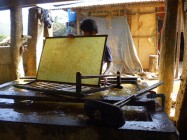English version below
Prendre du bambou de un an ; le couper en petits morceaux, le faire tremper dans un mélange de chaux et d’eau pendant trois ans.
Sortir la pâte et la mettre à bouillir soixante-douze heures puis la battre au pilon pendant 2 jours, jusqu’à ce qu’elle devienne très lisse ; rajouter de l’eau selon l’épaisseur voulue pour le papier, l’étendre sur des cadres en coton et faire sécher.
La production de papier en bambou est très répandue dans l’état Shan. A Chaukmè, c’est tout un quartier de la ville qui vit de cet artisanat, et toute la production part en Chine, sous forme de guirlandes et d’offrandes aux morts.
A Mandalay aussi, on fabrique ce papier de bambou pour un autre usage, celui des feuilles d’or que l’on applique sur les statues religieuses que l’on honore, au Rocher d’Or… Le papier, une fois séché, a une couleur jaune d’or. Il faut encore le frapper pendant plusieurs heures au pilon dans une cave chaude et humide pour le rendre résistant et parfaitement lisse, afin de ne rien perdre de la poudre d’or.
Take one-year-old bamboo
Cut into small pieces
Soak in a mixture of lime and water for three years.
Take out the dough and boil it for 72 hours then mash it for 2 days until it becomes very smooth;
Add water according to the thickness desired for the paper,
The production of bamboo paper is widespread in the Shan state. In Chaukmè, it is a whole district of the city that lives of this handicraft. All the production goes to China, in the form of garlands and offerings to the dead. In Mandalay too, people make bamboo paper for gold leaves to apply on monuments like the Golden Rock… The paper, once dried, has a golden yellow color. It is still necessary to hit it for several hours in a hot and humid room to make it resistant and perfectly smooth, not to lose anything of the gold powder.
